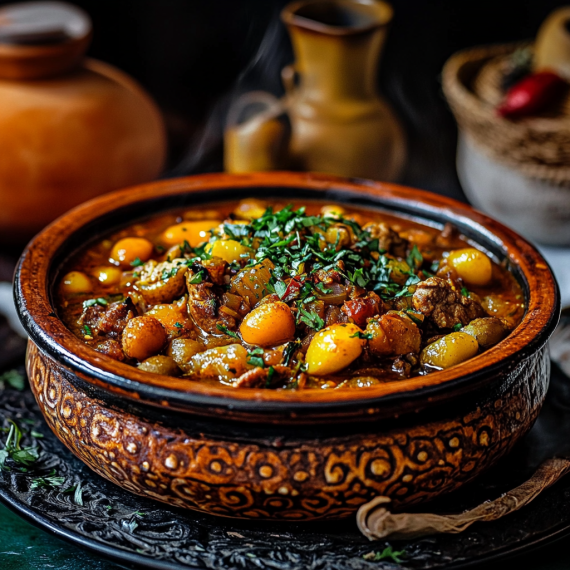Moroccan Tagine is a flavorful, soul-warming dish that captures the essence of North African cuisine. Originating from Morocco, this slow-cooked stew blends tender meats, aromatic spices, and fresh ingredients. Its signature cooking pot, also called a tagine, helps infuse the dish with rich flavors. Whether you’re making a lamb, chicken, or vegetable version, Moroccan Tagine offers endless variations to suit any palate. In this post, we’ll walk you through creating your own authentic Tagine at home, using the perfect blend of spices and ingredients to elevate your cooking experience.
What is Moroccan Tagine?
The History and Origin of Tagine
The history of Tagine dates back to ancient Morocco, where it was developed as a way to slow-cook meals over an open fire. The name “tagine” refers to both the dish and the clay cooking pot used to prepare it. This unique vessel has a conical lid that helps retain moisture, ensuring tender, flavorful dishes.
Tagine cooking became widespread in Morocco due to its practicality in a hot, arid climate. The method allows food to cook slowly, infusing rich spices like cumin, saffron, and Ras el Hanout.
Over time, it became a symbol of Moroccan hospitality, often served in large, communal portions. Today, tagine is enjoyed in many parts of the world, showcasing the diverse ingredients and flavors of North African cuisine.
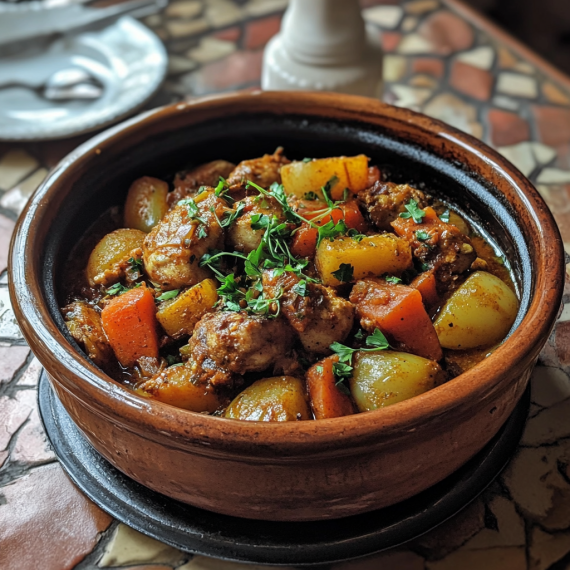
The Traditional Tagine Pot
The traditional Tagine pot is an essential part of Moroccan cuisine. Made from clay, it features a wide base and a conical lid. This design allows heat and moisture to circulate, keeping the ingredients tender and juicy. The lid traps steam, which condenses and falls back into the dish, ensuring a rich, flavorful stew.
Tagine pots are typically hand-crafted and can be found in various sizes. They come in both glazed and unglazed versions, with the unglazed ones offering a more rustic, earthy flavor. Traditionally, these pots are used over an open flame or in a charcoal oven.
Modern versions can be used on stovetops and in ovens, making it easier to prepare tagine at home. The pot is not just a cooking tool; it’s also a symbol of Moroccan culture, often passed down through generations.
Types of Moroccan Tagine Dishes
There are many types of Moroccan Tagine dishes, each offering unique flavors. The most common are lamb and chicken tagines, which are often paired with vegetables and dried fruits.
Lamb tagine, typically cooked with apricots or prunes, creates a beautiful balance of savory and sweet. Chicken tagine, on the other hand, is often combined with preserved lemons, olives, and a variety of spices. Vegetable tagines are popular among vegetarians and can include ingredients like carrots, potatoes, zucchini, and tomatoes. Fish tagines are also common, particularly along Morocco’s coastal regions.
The versatility of tagine allows for endless combinations of meats, vegetables, and spices, making it suitable for different tastes. Often, these dishes feature fragrant ingredients like saffron, cinnamon, and ginger, adding depth and richness to every bite.
Essential Ingredients for a Flavorful Moroccan Tagine
The Power of Moroccan Spices
Moroccan spices are the heart of a great tagine. These spices create layers of flavor that define Moroccan cuisine. One of the most important blends is Ras el Hanout, a mixture of up to 30 spices. It usually contains cumin, coriander, cinnamon, turmeric, and saffron.
These spices add warmth, depth, and complexity to the dish. Cumin is commonly used to enhance the savory flavors of meat and vegetables. Saffron, known for its unique floral taste, adds richness and a golden hue to tagine. Ginger and cinnamon provide a slight sweetness and earthiness.
In addition to these, paprika and turmeric add vibrant color and mild heat. These spices don’t just season the food; they create a fragrant aroma that fills the kitchen. The combination of spices in Moroccan Tagine elevates each dish, making it a truly aromatic experience.
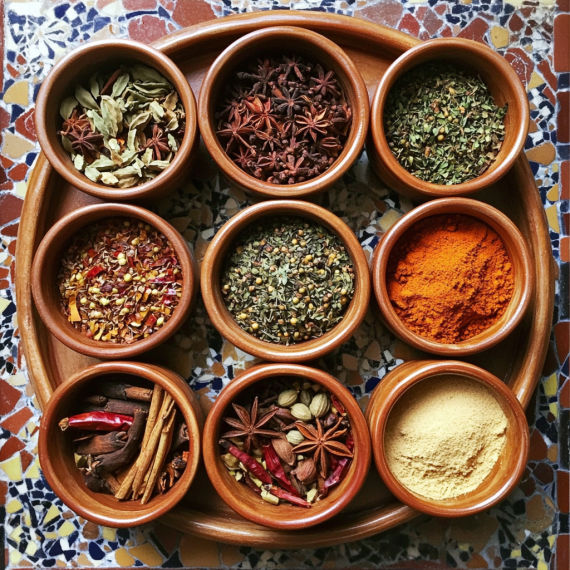
Proteins and Vegetables in Moroccan Tagine
Proteins and vegetables play a key role in Moroccan Tagine dishes. The most common proteins are lamb, chicken, and beef, but tagines can also feature fish or even a mix of meats.
Lamb tagine is particularly popular, often paired with dried fruits like apricots or prunes to balance the rich flavors. Chicken is frequently cooked with preserved lemons and olives, creating a tangy, savory contrast.
For vegetarian tagines, a variety of seasonal vegetables like carrots, potatoes, zucchini, and tomatoes are used. These vegetables absorb the spices and flavors during the slow cooking process. Root vegetables, like sweet potatoes, are also commonly featured for their sweetness.
The versatility of proteins and vegetables allows tagines to be customized based on personal preference or dietary restrictions, making it a truly adaptable dish. This flexibility is one of the reasons tagine remains a beloved staple of Moroccan cuisine.
Specialty Ingredients: Preserved Lemons and Olives
Preserved lemons and olives are key ingredients in many Moroccan Tagine dishes. Preserved lemons are made by fermenting fresh lemons in salt and their own juice. This process deepens their flavor, making them tangy and intensely aromatic. They add a unique citrusy brightness to tagine, balancing out the richness of the meat and spices. The rinds are usually sliced thin and incorporated into the dish, providing both flavor and texture.
Olives, especially green or black varieties, are also a staple in Moroccan cuisine. They bring a savory, briny flavor that complements the sweetness of fruits like apricots or prunes. Olives are often used alongside preserved lemons in tagines, creating a harmonious balance of flavors. Together, these ingredients bring depth and authenticity to the dish, making Moroccan tagine truly distinct and flavorful.
How to Cook Moroccan Tagine at Home
Choosing the Right Tagine Pot and Cooking Method
Choosing the right tagine pot and cooking method is essential for making an authentic dish. Traditional Moroccan Tagine pots are made from clay, featuring a wide base and a conical lid. The design helps circulate heat and moisture, creating tender, flavorful food. When selecting a tagine pot, it’s important to choose one with good heat retention. A well-made pot ensures even cooking and prevents burning.
For the cooking method, you can use a traditional stove or an oven. If you don’t have a clay tagine, a heavy-bottomed Dutch oven or casserole dish can work as a substitute. The key is to cook the dish slowly, allowing the flavors to meld. Some prefer using a gas or charcoal flame, while others opt for an oven for more consistent heat. Regardless of the method, slow cooking is essential for achieving the signature tenderness and depth of flavor in tagine.
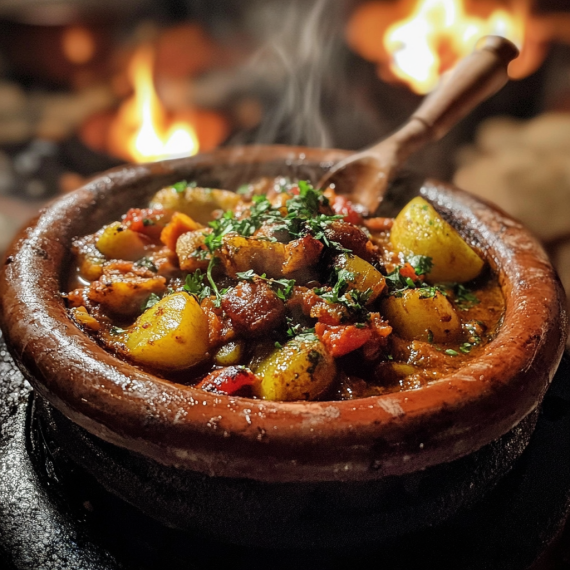
Step-by-Step Recipe for Lamb Moroccan Tagine
To make a delicious lamb Moroccan Tagine, start by heating olive oil in your tagine pot. Brown 1-2 pounds of lamb pieces on all sides. Remove the lamb and set it aside. In the same pot, sauté onions, garlic, and ginger until soft and fragrant. Add spices such as cumin, coriander, cinnamon, and turmeric, stirring them for 1-2 minutes to release their aroma.
Return the lamb to the pot and add 1 cup of water or broth. Add preserved lemons, olives, and dried fruits like apricots or prunes. Cover the tagine and simmer for 1.5 to 2 hours, stirring occasionally. If necessary, add more liquid to keep the dish moist. Once the lamb is tender, garnish with fresh cilantro or parsley.
Serve with couscous or flatbread for a complete meal. This simple yet flavorful recipe brings out the best of Moroccan spices and ingredients.
Cooking Tips for Perfect Moroccan Tagine
To achieve the perfect Moroccan Tagine, patience and attention to detail are key. First, always brown the meat before adding liquids. This step locks in flavor and ensures a rich, savory base. Next, use fresh, high-quality spices, as their aroma and taste greatly affect the dish.
When layering ingredients, place the tougher vegetables at the bottom, as they take longer to cook. This ensures everything cooks evenly. For the best tenderness, cook on low heat for an extended period, allowing the flavors to meld. Don’t rush the process; tagine is meant to be slow-cooked.
If the pot starts to dry out, add small amounts of water or broth. Avoid stirring too often, as this can disturb the cooking process. Lastly, let the dish rest for a few minutes after cooking. This allows the flavors to settle, creating a more cohesive and delicious meal.
Pairing Moroccan Tagine with Sides and Drinks
Perfect Sides to Serve with Moroccan Tagine
Moroccan Tagine is often served with simple sides that complement its rich flavors. One of the most popular choices is couscous. This fluffy, steamed grain soaks up the savory sauce from the tagine, making it a perfect match. You can also serve it with flatbread, which is great for dipping into the flavorful sauce.
For a fresh contrast, a light salad with ingredients like tomatoes, cucumbers, and olives adds brightness. The salad can be dressed with olive oil, lemon juice, and fresh herbs like parsley or mint. Another great option is roasted vegetables, which bring a slightly caramelized flavor that pairs well with tagine. Rice is another side that works well, especially if you prefer a more neutral base.
These sides help balance the richness of the tagine while enhancing the overall dining experience with texture and flavor variety.
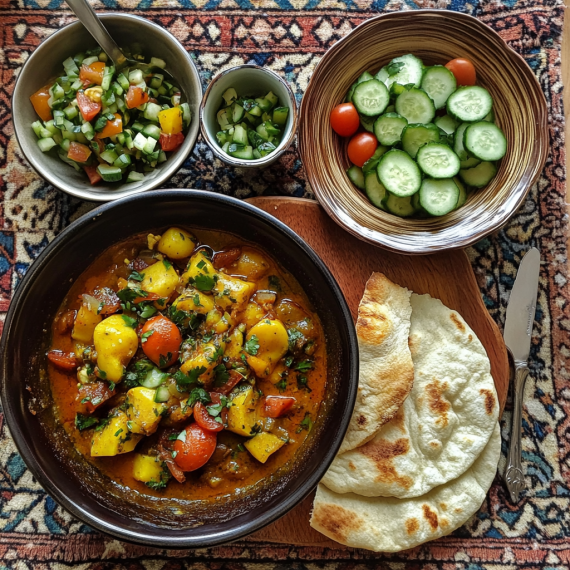
Drinks that Complement Moroccan Tagine
When serving Moroccan Tagine, drinks can enhance the meal’s flavors. Moroccan mint tea is the traditional choice, offering a sweet, refreshing contrast to the rich, savory dish. The combination of green tea, fresh mint, and sugar balances the spices in tagine perfectly.
For a lighter option, consider serving an iced hibiscus tea. Its tartness and floral notes add a nice contrast to the depth of tagine. Freshly squeezed lemonade, especially with a hint of mint, is another great choice. The citrusy freshness cuts through the richness of the dish, creating a bright balance.
You could also offer a ginger-lime drink, where the spice of ginger and the tang of lime provide a zesty pairing. These drinks bring out the best in Moroccan flavors, refreshing the palate between bites of tagine.
Garnishes and Finishes
Garnishes and finishes are the final touch that can elevate a Moroccan Tagine. Fresh cilantro or parsley adds a burst of color and a fresh, herbal flavor that complements the richness of the dish. For a bit of texture, sprinkle toasted almonds or sesame seeds on top. These add a delightful crunch and balance the softness of the meat and vegetables.
Raisins or chopped dried apricots can also be used as a sweet garnish, offering a pleasant contrast to the savory spices. A drizzle of olive oil or a squeeze of lemon juice just before serving brightens the dish and enhances the flavors. If you like heat, a dash of harissa or chili flakes can provide an extra kick.
These simple garnishes not only make the dish more visually appealing but also bring out the layers of flavor in every bite.
Why Moroccan Tagine is Perfect for Soul-Warming Meals
The Comforting Nature of Slow-Cooked Dishes
Slow-cooked dishes, like Moroccan Tagine, have a comforting, soul-warming quality. The slow cooking process allows flavors to meld, creating deep, rich tastes. As the dish simmers, the ingredients release their natural juices, resulting in tender meat and flavorful vegetables.
This method of cooking also creates a sense of anticipation, as the aromas build throughout the cooking time. The patience required to prepare a slow-cooked dish adds to its satisfaction, making it feel like a labor of love. Tagine, in particular, is perfect for family gatherings or cozy dinners, as it brings people together. The hearty, aromatic flavors make it ideal for colder months, offering warmth and comfort with every bite.
Additionally, slow cooking often enhances the nutritional value of the dish by preserving vitamins and minerals, making it both delicious and nourishing.
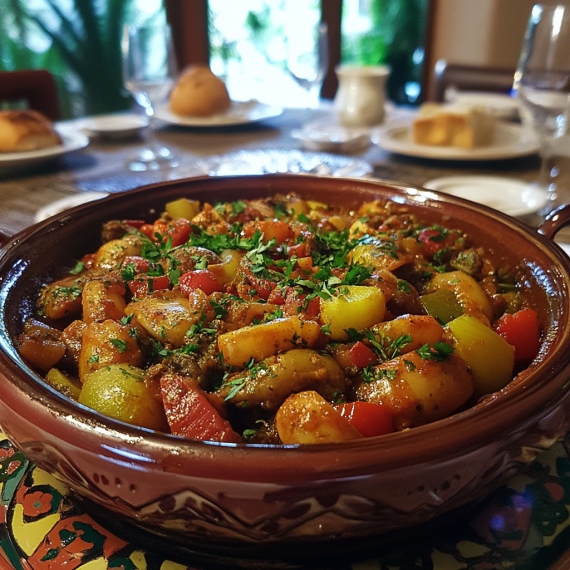
Tagine as a Symbol of Moroccan Hospitality
Tagine is more than just a dish; it’s a symbol of Moroccan hospitality. In Morocco, meals are often served in large, communal portions, with tagine being the centerpiece. The act of sharing this flavorful dish reflects the warmth and generosity of Moroccan culture. It is common for guests to be offered a bowl of tagine as a sign of respect and welcome.
The slow-cooked nature of the dish encourages conversation and connection, as people gather around the table to enjoy the meal together. The rich flavors of tagine also evoke a sense of comfort, making it ideal for family gatherings and celebrations.
By offering tagine, hosts demonstrate care and effort in preparing a meal that brings people together, fostering an atmosphere of warmth and hospitality. This tradition is deeply ingrained in Moroccan culture and highlights the importance of sharing food with others.
How to Customize Your Moroccan Tagine for Every Taste
Customizing your Moroccan Tagine allows you to tailor the dish to suit every taste. For meat lovers, lamb, chicken, and beef are common choices, but you can also experiment with duck or even goat. If you’re vegetarian, a mix of seasonal vegetables like sweet potatoes, carrots, and squash makes a satisfying tagine.
For added flavor, try adding beans or lentils for a hearty, plant-based option. Adjust the spices to match your preferences, whether you prefer a milder tagine with just cumin and coriander or a bolder dish with cinnamon, saffron, and chili.
You can also switch up the fruit: dried apricots, raisins, or figs offer sweetness, but pomegranate seeds or fresh citrus can add a tangy twist. For those who like heat, add more chili or harissa. This flexibility makes tagine perfect for any diet, whether gluten-free, halal, or vegan, ensuring it’s always a crowd-pleaser.
Conclusion
Moroccan Tagine is a versatile, flavorful dish that brings warmth and comfort to any meal. Its rich history, aromatic spices, and customizable ingredients make it a true reflection of Moroccan hospitality. Whether you’re cooking it for a family dinner or a special occasion, tagine is sure to impress.
With its slow-cooked tenderness and depth of flavor, it’s a dish that’s perfect for sharing. Explore different variations, sides, and drinks to create a memorable dining experience. Don’t hesitate to make tagine your next culinary adventure—it’s a dish that’s as rich in flavor as it is in tradition.

